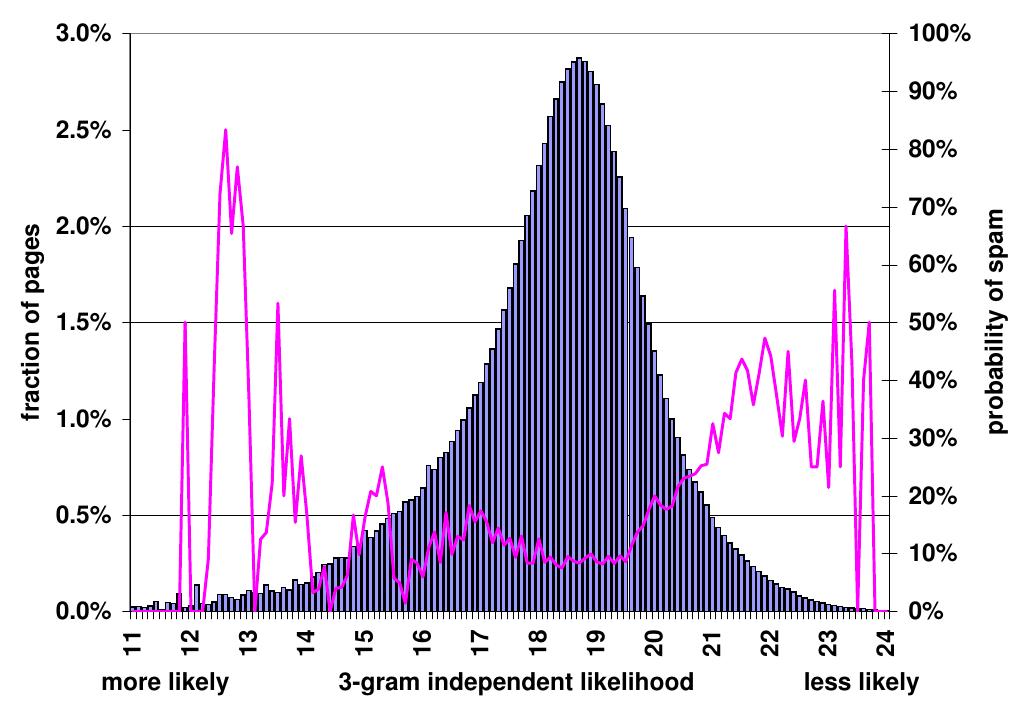Detecting spam web pages through content analysis
2006, Proceedings of the 15th international conference on World Wide Web - WWW '06
https://doi.org/10.1145/1135777.1135794Abstract
In this paper, we continue our investigations of "web spam": the injection of artificially-created pages into the web in order to influence the results from search engines, to drive traffic to certain pages for fun or profit. This paper considers some previously-undescribed techniques for automatically detecting spam pages, examines the effectiveness of these techniques in isolation and when aggregated using classification algorithms. When combined, our heuristics correctly identify 2,037 (86.2%) of the 2,364 spam pages (13.8%) in our judged collection of 17,168 pages, while misidentifying 526 spam and non-spam pages (3.1%).
References (32)
- REFERENCES
- S. Adali, T. Liu and M. Magdon-Ismail. Optimal Link Bombs are Uncoordinated. In 1st International Workshop on Adversarial Information Retrieval on the Web, May 2005.
- E. Amitay, D. Carmel, A. Darlow, R. Lempel and A. Soffer. The Connectivity Sonar: Detecting Site Functionality by Structural Patterns. In 14th ACM Conference on Hypertext and Hypermedia, Aug. 2003.
- R. Baeza-Yates, C. Castillo and V. López. PageRank Increase under Different Collusion Topologies. In 1st International Workshop on Adversarial Information Retrieval on the Web, May 2005.
- A. Benczúr, K. Csalogány, T. Sarlós and M. Uher. SpamRank -Fully Automatic Link Spam Detection. In 1st International Workshop on Adversarial Information Retrieval on the Web, May 2005.
- L. Breiman. Bagging Predictors. In Machine Learning, Vol. 24, No. 2, pages 123-140, 1996.
- U.S. Census Bureau. Quarterly Retail E-Commerce Sales - 4th Quarter 2004. http://www.census.gov/mrts/www/data/html/04Q4.html (dated Feb. 2005, visited Sept. 2005)
- B. Davison. Recognizing Nepotistic Links on the Web. In AAAI-2000 Workshop on Artificial Intelligence for Web Search, July 2000.
- D. Fetterly, M. Manasse and M. Najork. Spam, Damn Spam, and Statistics: Using statistical analysis to locate spam web pages. In 7th International Workshop on the Web and Databases, June 2004.
- D. Fetterly, M. Manasse and M. Najork. Detecting Phrase-Level Duplication on the World Wide Web. In 28th Annual International ACM SIGIR Conference on Research and Development in Information Retrieval, Aug. 2005.
- Y. Freund and R. E. Schapire. A decision-theoretic generalization of on-line learning and an application to boosting. In European Conference on Computational Learning Theory, 1995.
- Z. Gyöngyi, H. Garcia-Molina and J. Pedersen. Combating Web Spam with TrustRank. In 30th International Conference on Very Large Data Bases, Aug. 2004.
- Z. Gyöngyi and H. Garcia-Molina. Link Spam Alliances. In 31st International Conference on Very Large Data Bases, Aug. 2005.
- Z. Gyöngyi and H. Garcia-Molina. Web Spam Taxonomy. In 1st International Workshop on Adversarial Information Retrieval on the Web, May 2005.
- GZIP. http://www.gzip.org/
- M. Henzinger, R. Motwani and C. Silverstein. Challenges in Web Search Engines. SIGIR Forum 36(2), 2002.
- J. Hidalgo. Evaluating cost-sensitive Unsolicited Bulk Email categorization. In 2002 ACM Symposium on Applied Computing, Mar. 2002.
- B. Jansen and A. Spink. An Analysis of Web Documents Retrieved and Viewed. In International Conference on Internet Computing, June 2003.
- C. Johnson. US eCommerce: 2005 To 2010. http://www.forrester.com/Research/Document/Excerpt/ 0,7211,37626,00.html (dated Sept. 2005, visited Sept. 2005)
- C. Manning and H. Schütze. Foundations of Statistical Natural Language Processing. The MIT Press, 1999, Cambridge, Massachusetts.
- P. Metaxas and J. DeStefano. Web Spam, Propaganda and Trust. In 1st International Workshop on Adversarial Information Retrieval on the Web, May 2005.
- G. Mishne, D. Carmel and R. Lempel. Blocking Blog Spam with Language Model Disagreement. In 1st International Workshop on Adversarial Information Retrieval on the Web, May 2005.
- MSN Search. http://search.msn.com/
- J. Nielsen. Statistics for Traffic Referred by Search Engines and Navigation Directories to Useit. http://useit.com/about/searchreferrals.html (dated April 2004, visited Sept. 2005)
- L. Page, S. Brin, R. Motwani and T. Winograd. The PageRank Citation Ranking: Bringing Order to the Web. Stanford Digital Library Technologies Project, 1998.
- A. Perkins. The Classification of Search Engine Spam. http://www.silverdisc.co.uk/articles/spam-classification/ (dated Sept. 2001, visited Sept. 2005)
- J. R. Quinlan. C4.5: Programs for Machine Learning. Morgan-Kaufman, 1993.
- J. R. Quinlan. Bagging, Boosting, and C4.5. In 13th National Conference on Artificial Intelligence and 8th Innovative Applications of Artificial Intelligence Conference, Vol. 1, 725-730, Aug. 1996.
- M. Sahami, S. Dumais, D. Heckerman and E. Horvitz. A Bayesian Approach to Filtering Junk E-Mail. In Learning for Text Categorization: Papers from the 1998 Workshop, AAAI Technical Report WS-98-05, 1998.
- B. Wu and B. Davison. Identifying Link Farm Spam Pages. In 14th International World Wide Web Conference, May 2005.
- B. Wu and B. Davison. Cloaking and Redirection: a preliminary study. In 1st International Workshop on Adversarial Information Retrieval on the Web, May 2005.
- H. Zhang, A. Goel, R. Govindan, K. Mason and B. Van Roy. Making Eigenvector-Based Systems Robust to Collusion. In 3rd International Workshop on Algorithms and Models for the Web Graph, Oct. 2004.















